
A bicycle, also called a pedal cycle, bike, push-bike or cycle, is a human-powered or motor-assisted, pedal-driven, single-track vehicle, with two wheels attached to a frame, one behind the other. A bicycle rider is called a cyclist, or bicyclist.

A recumbent bicycle is a bicycle that places the rider in a laid-back reclining position. Some recumbent riders may choose this type of design for ergonomic reasons: the rider's weight is distributed comfortably over a larger area, supported by back and buttocks. On a traditional upright bicycle, the body weight rests entirely on a small portion of the sitting bones, the feet, and the hands.

A chair is a type of seat, typically designed for one person and consisting of one or more legs, a flat or slightly angled seat and a back-rest. It may be made of wood, metal, or synthetic materials, and may be padded or upholstered in various colors and fabrics.
Indoor cycling, often called spinning, is a form of exercise with classes focusing on endurance, strength, intervals, high intensity and recovery, and involves using a special stationary exercise bicycle with a weighted flywheel in a classroom setting. When people took cycling indoors in the late 19th century, whether for reasons of weather or convenience, technology created faster, more compact and efficient machines over time. The first iterations of the stationary bike ranged from the vertical Gymnasticon to regular bicycles on rollers.
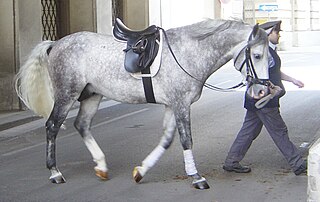
English saddles are used to ride horses in English riding disciplines throughout the world. The discipline is not limited to England, the United Kingdom in general or other English-speaking countries. This style of saddle is used in all of the Olympic and International Federation for Equestrian Sports (FEI) equestrian disciplines, except for the newly approved FEI events of equestrian vaulting and reining. Most designs were specifically developed to allow the horse freedom of movement, whether jumping, running, or moving quickly across rugged, broken country with fences. Unlike the western saddle or Australian Stock Saddle, there is no horn or other design elements that stick out above the main tree of the saddle.

Western saddles are used for western riding and are the saddles used on working horses on cattle ranches throughout the United States, particularly in the west. They are the "cowboy" saddles familiar to movie viewers, rodeo fans, and those who have gone on trail rides at guest ranches. This saddle was designed to provide security and comfort to the rider when spending long hours on a horse, traveling over rugged terrain.
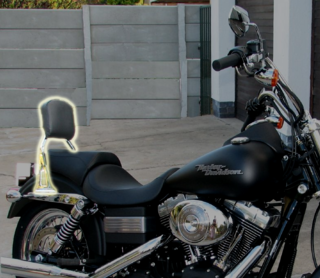
A sissy bar, also called a "sister bar" or "passenger backrest", is an addition to the rear of a bicycle or motorcycle that allows the rider or passenger to recline against it while riding. Alternatively it can serve as an anchor point or support for mounting luggage or equipment that is not part of the bike. They can serve as one of the main mounts securing the rear fender to the motorcycle. Over the years the sissy bars have been a focal point of expression for the bike builder. Custom sissy bar designs can be simple or extravagant. They can be built for comfort, purpose, style or a combination of all three.

Cycling shorts are short, skin-tight garments designed to improve comfort and efficiency while cycling.

Cycling gloves are gloves designed for cycling. They may provide warmth, comfort and protection.
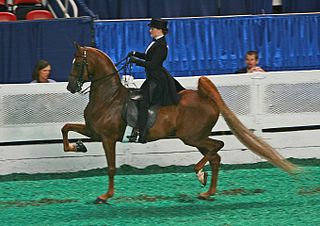
Saddle seat is a style of horse riding within the category of English riding that is designed to show off the high action of certain horse breeds. The style developed into its modern form in the United States, and is also seen in Canada and South Africa. To a much lesser extent, it is ridden with American horse breeds in Europe and Australia.
A saddle sore in humans is a skin ailment on the buttocks due to, or exacerbated by, horse riding or cycling on a bicycle saddle. It often develops in three stages: skin abrasion, folliculitis, and finally abscess.
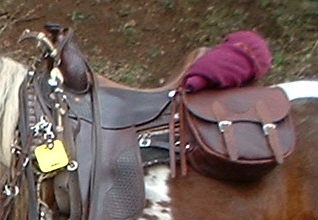
Saddlebags are bags that are attached to saddles.

A saddle is a supportive structure for a rider of an animal, fastened to an animal's back by a girth. The most common type is equestrian. However, specialized saddles have been created for oxen, camels and other animals. It is not known precisely when riders first began to use some sort of padding or protection, but a blanket attached by some form of surcingle or girth was probably the first "saddle", followed later by more elaborate padded designs. The solid saddle tree was a later invention, and though early stirrup designs predated the invention of the solid tree, the paired stirrup, which attached to the tree, was the last element of the saddle to reach the basic form that is still used today. Today, modern saddles come in a wide variety of styles, each designed for a specific equestrianism discipline, and require careful fit to both the rider and the horse. Proper saddle care can extend the useful life of a saddle, often for decades. The saddle was a crucial step in the increased use of domesticated animals, during the Classical Era.

A bicycle saddle, sometimes called a bicycle seat, is one of five contact points on an upright bicycle, the others being the two pedals and the two handles on the handlebars. The bicycle saddle has been known as such since the bicycle evolved from the draisine, a forerunner of the bicycle. It performs a similar role as a horse's saddle, not bearing all the weight of the rider as the other contact points also take some of the load.

Bareback riding is a form of horseback riding without a saddle. It requires skill, balance, and coordination, as the rider does not have any equipment to compensate for errors of balance or skill.

A horse harness is a device that connects a horse to a horse-drawn vehicle or another type of load to pull. There are two main designs of horse harness: (1) the breast collar or breaststrap, and (2) the full collar or collar-and-hames.
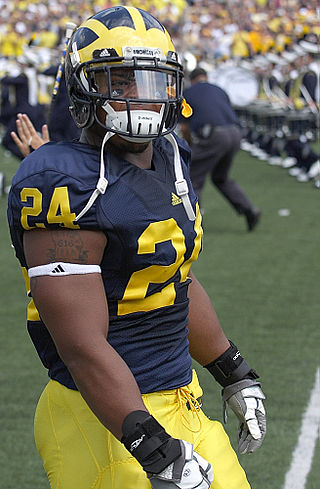
Protective equipment in gridiron football consists of equipment worn by football players for the protection of the body during the course of a football game. Basic equipment worn by most football players include helmet, shoulder pads, gloves, shoes, and thigh and knee pads, a mouthguard, and a jockstrap or compression shorts with or without a protective cup. Neck rolls, elbow pads, hip pads, tailbone pads, rib pads, and other equipment may be worn in addition to the aforementioned basics. Football protective equipment is made of synthetic materials: foam rubbers, elastics, and durable, shock-resistant, molded plastic. Football protective equipment has remained consistent in use for decades with some slight modifications made over the years in design and materials. The assignment and maintenance of football gear belongs to the team equipment manager.
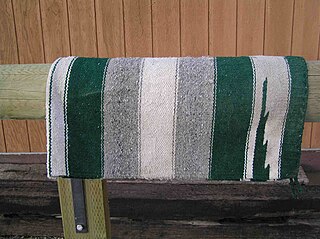
The terms saddle blanket, saddle pad, and saddle cloth refer to blankets, pads or fabrics inserted under a saddle. These are usually used to absorb sweat, cushion the saddle, and protect the horse's back. There are lighter types of saddle cloth, such as the shabrack, used primarily for decorative purposes, often placed over the top of a more utilitarian pad.















